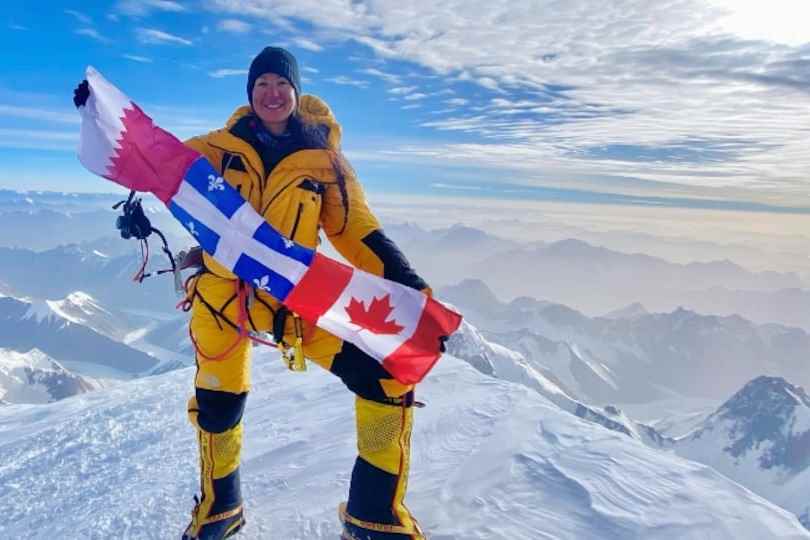Posted at 8:15 p.m.
“It’s a mixture of pride with a kind of endless gratitude that the mountain gave way to you. »
Marie-Pier Desharnais reached the summit of K2 at 5:45 a.m. on the morning of July 22. When talking with The PressFriday morning, the native of Victoriaville was still in Skardu, a small town in Pakistan on the edge of the mountains.
At the end of the line, the 36-year-old woman is looking for the words to describe the feeling that once filled her feet on the mountain, recognized as one of the most difficult and most dangerous in the world. “It’s just an indescribable feeling “, she breathes.
The Quebecer will forever remember that moment when the sun rose, about 45 minutes before the culmination of six weeks of effort. Moved, she let a few tears flow.
“You’re getting warmed up, when you’ve been cold all night. You swarm your toes and fingers so you don’t get frostbite. And then, finally, the day dawns. The sun is warming up. The colors on the mountains are stupid. You are close to the top,” she says.
Up there, at an altitude of 8611 meters, she waved the flags of Quebec, Canada and Qatar – countries where she lived for 10 years.
“Thank you for the lessons. For giving me the right of way. For changing me. I take you with me. You are part of me,” she wrote on her social media once back at base camp. Words that express well the relationship it has with K2, nicknamed the “wild mountain”.
Shipping
Marie-Pier Desharnais began her expedition on June 11, the day she arrived in Pakistan. She was part of a group of 11 people (six women and five men) led by Nirmal Purja, which we could see in the film 14 Peaks: Nothing is Impossible.
“I’ve been climbing with him for three years and there was no way I was climbing with anyone other than him for the K2,” she explains.
Before attacking the summit push, the group made a first rotation, which consists of climbing the mountain for the first time to camp 3, then descending to base camp. “We will shock the body at altitude so that it produces more red blood cells and we can be able to live with less oxygen,” she explains.
Upon returning to base camp, the group prepared to complete the full ascent. He had to wait 12 days before the conditions were ideal and conducive to success. Desharnais and his acolytes began the climb on July 19. They slept one night at Camp 1, the same at Camps 3 and 4.
“Generally, people attack the summit push from camp 4. We skipped it. When you sleep high in altitude, you weaken. Your body has less oxygen, you are less rested, you don’t sleep well. »
While things went smoothly on the way up, they got more complicated on the “hellish” 12-hour descent. A rock fell on the Quebecer’s hand; the pain was so intense she thought her joints were fractured. “In the end, it’s just cracked,” she said.
The climber had to rappel with one hand, as the rocks continued to fall. “That’s the biggest threat with K2. We may be equipped, have climbing skills, there are elements that we do not control, such as falling rocks. If you have the misfortune to be in the wrong place at the wrong time, it’s truly Russian roulette. »
“Elevating the Feminine Footprint”
Marie-Pier Desharnais left Quebec at age 25 to pursue her master’s studies in the Maldives, which focused on post-tsunami recovery. She is herself a survivor of the 2004 tsunami. One thing leading to another, she found herself in Qatar, where her ex-fiancé lived. She spent 10 years there, working in disaster management.
It has now been three and a half years since she adopted the nomadic way of life and climbs “more diligently”. She also launched the Apex Woman Project, which consists of climbing five of the most difficult mountains in the world.
“I spent 10 years in the Middle East in a professional environment that was almost strictly reserved for men. My passion was mountaineering, an area almost exclusively reserved for men. I was told: “You managed this mountain in such a long time, you are fast for a woman…”
I had enough of it. I said to myself: it is not because we are a woman that we should dream less strongly. If I start climbing like this, I can raise the feminine footprint on the highest, most difficult mountains. We’re going to show them that extreme sports aren’t just for men.
Marie-Pier Desharnais
Marie-Pier Desharnais now has ideas for polar expeditions in Antarctica. And she is “not done with the Himalayas”, she warns.
“I don’t think I will have enough of a life to do everything I want to do,” says the mountaineer.
As Marvin Gaye and Tammi Terrell sang: Ain’t no mountain high enough. (There is no mountain high enough.)
Lighthearted
In 2018, mountaineer Serge Dessureault died while attempting to climb K2. In the past few days, another Quebecer, Richard Cartier, also lost his life there, as did one of his partners, Australian Matthew Eakin.
Marie-Pier Desharnais met Richard Cartier’s group at Camp 3 the day before the two men died. “We had become friends,” she says. We were light-hearted, we were joking. When she returned to base camp, she learned that the Quebecer was missing. “It completely shocked me, it upset me. [Richard] is an experienced man. It puts things into perspective. It makes you think. »

